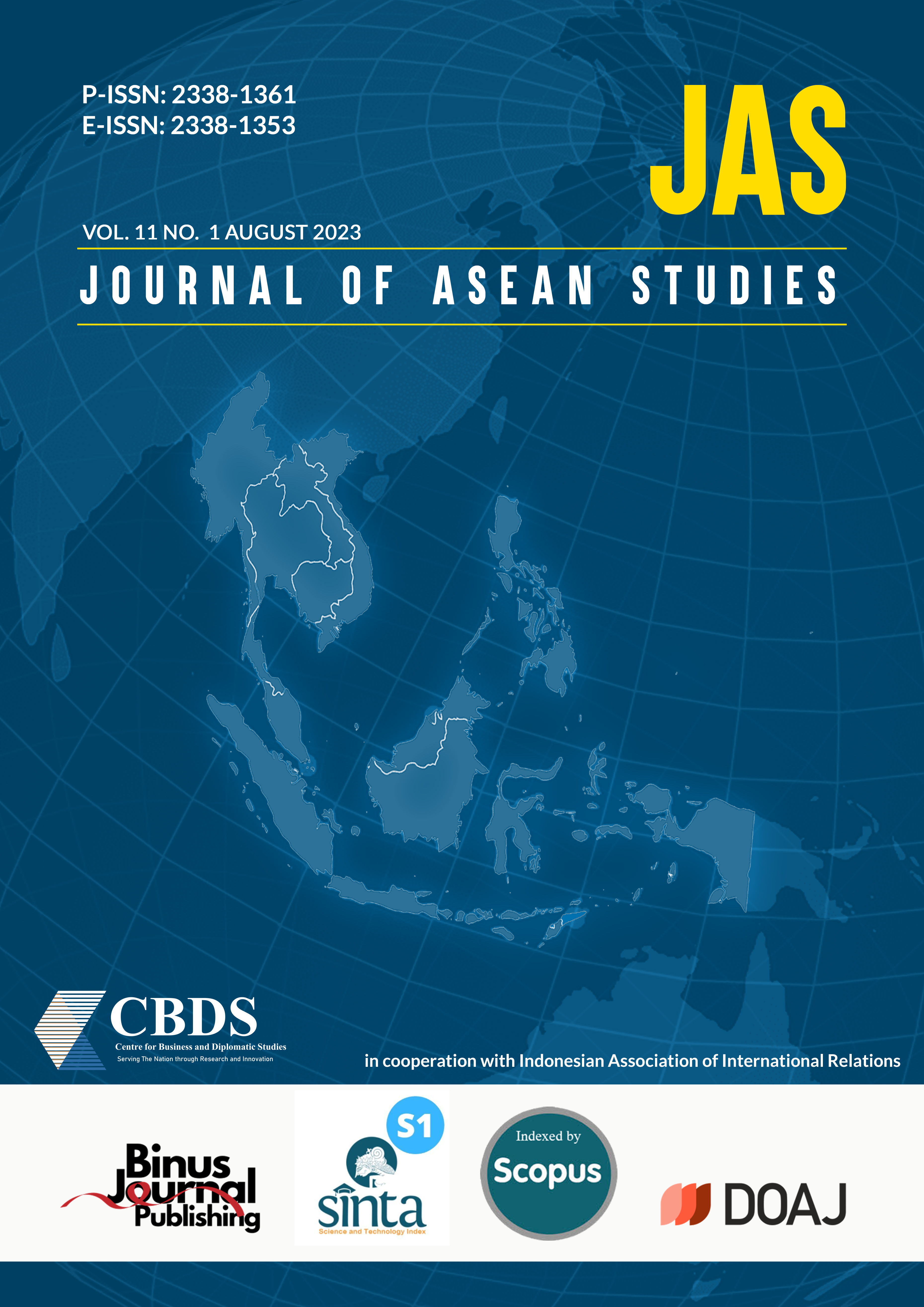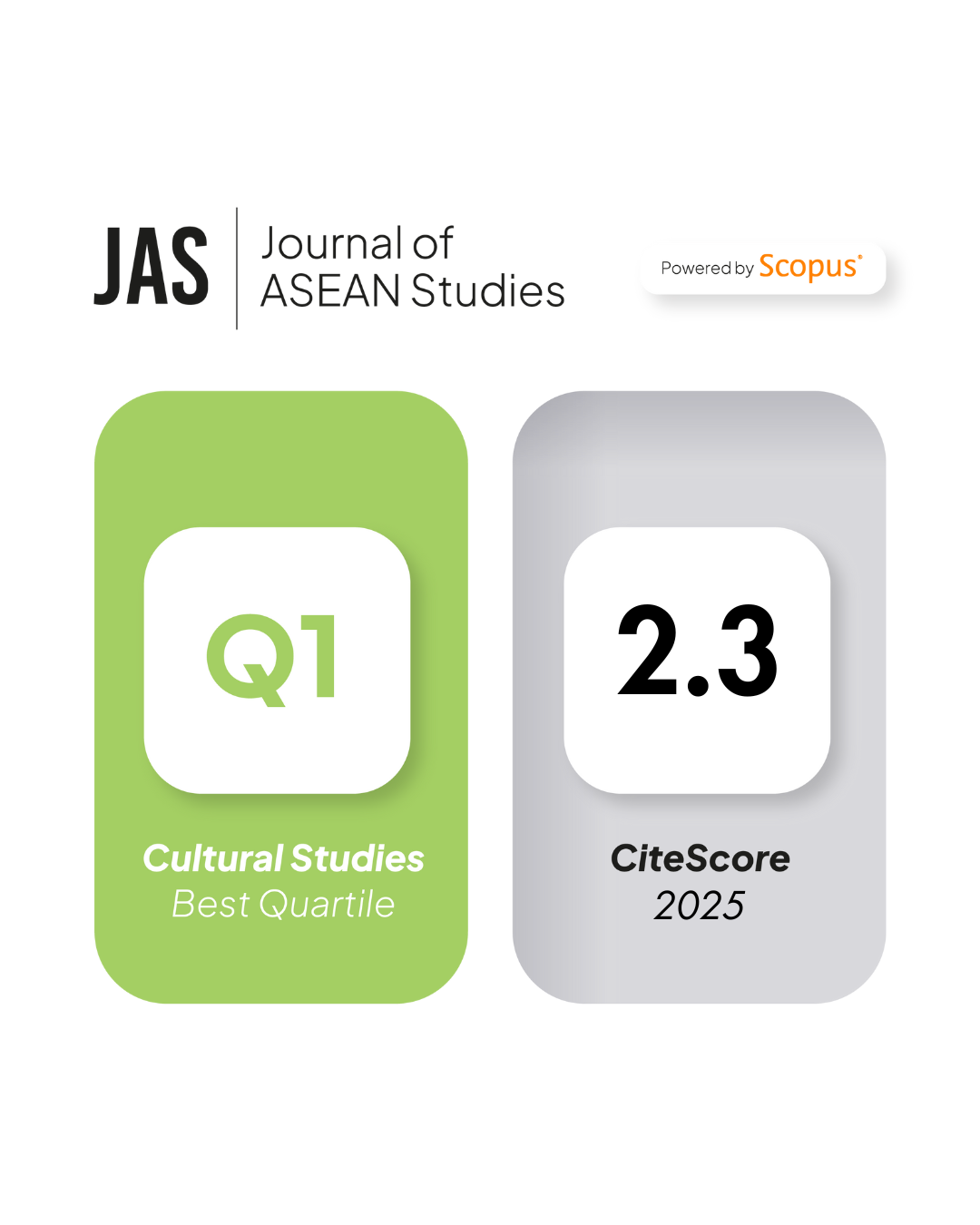Family Business Dynamics in Southeast Asia: A Comparative Study of Indonesia, Malaysia, Singapore, and Thailand
DOI:
https://doi.org/10.21512/jas.v11i1.9518Keywords:
South East Asian, family business, comparative analysisAbstract
The research discussed the literature on family business in four Southeast Asian countries, namely Indonesia, Malaysia, Singapore, and Thailand. The four countries were selected as case studies to contextualize the southeast Asian family business context. In addition, the research perceived that the four countries have similar sociocultural characteristics, potentially providing similar attributes to how family businesses establish and grow. Drawing from literature collected from the Scopus database through the keywords “family business,†“Indonesia,†“Malaysia,†“Thailand,†and “Singapore,†the research provided the dynamics of knowledge production through systemic literature review. A narrative literature review was implemented to provide a high level of abstraction to the literature on family business differences and similarities. The findings show that the theme of succession was widely discussed in the literature. Succession in all four countries still prioritizes members of the family as successors. However, literature in Indonesia provides a more in-depth understanding of the way succession works. The research enriches the present discussion and provides insights for researchers on the research gap in family business issues. At a practical level, the research provides insight for professionals who work in the sector to gain insight into how family businesses work to maintain their entrepreneurial spirit.
References
Ambarriani, A. S., & Purwanugraha, H. A. (2012). Management practice, firm size and performance of individual family firm: Evidence from Indonesian’s batik industry. International Journal of Economic Policy in Emerging Economies, 5(4), 296-307. https://doi.org/10.1504/IJEPEE.2012.052305
Ang, J. S., Cole, R. A., & Lin, J. W. (2000). Agency Costs and Ownership Structure. The Journal of Finance, 55(1), 81–106. https://doi.org/10.1111/0022-1082.00201
Anggadwita, G., Profityo, W. B., Alamanda, D. T., & Permatasari, A. (2019). Cultural values and their implications to family business succession: A case study of small Chinese-owned family businesses in Bandung, Indonesia. Journal of Family Business Management, 10(4), 281-292. https://doi.org/10.1108/JFBM-03-2019-0017
Astrachan, J. H., Klein, S. B., & Smyrnios, K. X. (2002). The F-PEC scale of family influence: A proposal for solving the family business definition problem1. Family business review, 15(1), 45-58. https://doi.org/10.1111/j.1741-6248.2002.00045.x
Augendra, B., Bernard, T., & Ani, W. (2019). Why micro and small family enterprises do not borrow from microcredit institutions? A case study in East Java, Indonesia. Studies in Business & Economics, 14(3). https://doi.org/10.2478/sbe-2019-0040
Barbera, F., Stamm, I., & DeWitt, R.-L. (2018). The development of an entrepreneurial legacy: Exploring the role of anticipated futures in transgenerational entrepreneurship. Family Business Review, 31(3), 352-378. https://doi.org/10.1177/0894486518780795
Barkema, H. G., Chen, X.-P., George, G., Luo, Y., & Tsui, A. S. (2015). West meets East: New concepts and theories. Academy of Management Journal, 58(2), 460-479. https://doi.org/10.5465/amj.2015.4021
Barral, S. (2018). In between agro-industries and family business farms: Ephemeral smallholder family plantations in Indonesia. In P-M. Bosc, J-M. Sourisseau, P. Bonnal, P. Gasselin, É. Valette, & J-F. Bélières (Eds.), Diversity of Family Farming Around the World (pp. 137-148). Springer.
Bernhard, F., & O’Driscoll, M. P. (2011). Psychological Ownership in Small Family-Owned Businesses: Leadership Style and Nonfamily-Employees’ Work Attitudes and Behaviors. Group & Organization Management, 36(3), 345–384. https://doi.org/10.1177/1059601111402684
Bocatto, E., Gispert, C., & Rialp, J. (2010). Familyâ€Owned Business Succession: The Influence of Preâ€performance in the Nomination of Family and Nonfamily Members: Evidence from Spanish Firms. Journal of Small Business Management, 48(4), 497–523. https://doi.org/10.1111/j.1540-627X.2010.00306.x
Bodolica, V., Dupuis, D., & Spraggon, M. (2020). At the intersection of corporate governance and performance in family business settings: Extant knowledge and future research. Business Ethics: A European Review, 29(1), 143–166. https://doi.org/10.1111/beer.12254
Buttner, E. H., & Moore, D. P. (1997). Women’s organizational exodus to entrepreneurship: Self-reported motivations and correlates with success. Journal of Small Business Management, 35, 34–46.
Carlsson, G., & Karlsson, K. (1970). Age, Cohorts and the Generation of Generations. American Sociological Review, 35(4), 710–718. https://doi.org/10.2307/2093946
Cheong, K.-C., Lee, P.-P., & Lee, K.-H. (2015). The internationalisation of family firms: Case histories of two Chinese overseas family firms. Business History, 57(6), 841–861. https://doi.org/10.1080/00076791.2014.982106
Chong, P., Ong, T., Abdullah, A., & Choo, W. (2019). Internationalisation and innovation on balanced scorecard (BSC) among Malaysian small and medium enterprises (SMEs). Management Science Letters, 9(10), 1617–1632.
Chou, S. Y., Chang, T., & Han, B. (2016). A Buddhist application of corporate social responsibility: Qualitative evidence from a case study of a small Thai family business. Small Enterprise Research, 23(2), 116–134. https://doi.org/10.1080/13215906.2016.1221359
Cohn, M. (1990). Passing the torch: Transfer strategies for your family business. Liberty Hall Press.
Chung, P-Y. (2005). Changes and continuities. Evolution of a Chinese family business (1876–2004). Asia Europe Journal, 3(2), 259-268. https://doi.org/10.1007/s10308-005-0145-9
Daily, C. M., & Dollinger, M. J. (1992). An Empirical Examination of Ownership Structure in Family and Professionally Managed Firms. Family Business Review, 5(2), 117–136. https://doi.org/10.1111/j.1741-6248.1992.00117.x
Dinh, T. Q., & Calabrò, A. (2019). Asian family firms through corporate governance and institutions: A systematic review of the literature and agenda for future research. International Journal of Management Reviews, 21(1), 50-75. https://doi.org/10.1111/ijmr.12176
Dumas, C. (1989). Understanding of Father-Daughter and Father-Son Dyads in Family-Owned Businesses. Family Business Review, 2(1), 31–46. https://doi.org/10.1111/j.1741-6248.1989.00031.x
Efferin, S., & Hartono, M. S. (2015). Management control and leadership styles in family business: An Indonesian case study. Journal of Accounting & Organizational Change, 11(1), 130-159. http://dx.doi.org/10.1108/JAOC-08-2012-0074
Fang, H. C., Singh, K., Kim, T., Marler, L., & Chrisman, J. J. (2021). Family business research in Asia: review and future directions. Asia Pacific Journal of Management, 39, 1215-1256. https://doi.org/10.1007/s10490-021-09760-2
Fendiani, A., & Tandiono, R. (2016). Family business and managerial ownership: the effect on the degree of accounting conservatism practised in Indonesian-listed firms. Pertanika Journal of Sociacl Sciences & Humanities, 24, 109-118.
Fletcher, D., Melin, L., & Gimeno, A. (2012). Culture and values in family business—A review and suggestions for future research. Journal of Family Business Strategy, 3(3), 127-131. https://doi.org/10.1016/j.jfbs.2012.06.001
Fock, S.-T. (1998). The impact of family conflicts on the development of the Chinese entrepreneurially managed family business: The Yeo Hiap Seng Case in Singapore. Journal of Small Business & Entrepreneurship, 15(2), 88-102. https://doi.org/10.1080/08276331.1998.10593285
Franks, J., Mayer, C., Volpin, P., & Wagner, H. F. (2012). The life cycle of family ownership: International evidence. The Review of Financial Studies, 25(6), 1675-1712. https://doi.org/10.1093/rfs%2Fhhr135
Gómez-MejÃa, L. R., Haynes, K. T., Núñez-Nickel, M., Jacobson, K. J. L., & Moyano-Fuentes, J. (2007). Socioemotional Wealth and Business Risks in Family-controlled Firms: Evidence from Spanish Olive Oil Mills. Administrative Science Quarterly, 52(1), 106–137. https://doi.org/10.2189/asqu.52.1.106
Greenhaus, J. H., Collins, K. M., & Shaw, J. D. (2003). The relation between work–family balance and quality of life. Journal of Vocational Behavior, 63(3), 510–531. https://doi.org/10.1016/S0001-8791(02)00042-8
Hendayani, R., & Febrianta, M. Y. (2020). Technology as a driver to achieve the performance of family businesses supply chain. Journal of Family Business Management. http://dx.doi.org/10.1108/JFBM-10-2019-0070
Henssen, B., Voordeckers, W., Lambrechts, F., & Koiranen, M. (2014). The CEO autonomy–stewardship behavior relationship in family firms: The mediating role of psychological ownership. Journal of Family Business Strategy, 5(3), 312–322. https://doi.org/10.1016/j.jfbs.2014.01.012
Hertzman, E. (2020). What does it mean to be ‘called home’from overseas? The case of Hakka Chinese Indonesian youth from West Kalimantan. Journal of Ethnic and Migration Studies, 46(16), 3526-3542. https://doi.org/10.1080/1369183X.2019.1592415
Ho, S., & Chalam, S. (2017, January 10). A new wave. Brunswick. https://www.brunswickgroup.com/a-new-wave-i2813/
Hollander, B. S., & Bukowitz, W. R. (1990). Women, Family Culture, and Family Business. Family Business Review, 3(2), 139–151. https://doi.org/10.1111/j.1741-6248.1990.00139.x
Ikävalko, M., Pihkala, T., & Jussila, I. (2006). Psychological ownership and family businesses–Identifying the common ground through discriminant analysis.
Ismail, H. N., Mohd Puzi, M. A., Banki, M. B., & Yusoff, N. (2019). Inherent factors of family business and transgenerational influencing tourism business in Malaysian islands. Journal of Tourism and Cultural Change, 17(5), 624–641. https://doi.org/10.1080/14766825.2018.1549058
Istiatin, & Luhgianto. (2017). Success key to creating third-generation achievement: A case study in family business in Indonesia. International Journal of Civil Engineering and Technology, 8(11), 803-810.
Joni, J., Ahmed, K., & Hamilton, J. (2020). Politically connected boards, family business groups and firm performance: Evidence from Indonesia. Journal of Accounting & Organizational Change, 16(1), 93-121. https://doi.org/10.1108/JAOC-09-2019-0091
Kets de Vries, M. F. (1996). Family business: Human dilemmas in the family firm: text and cases. International Thomson Business Press.
Kilenthong, W. T., & Rueanthip, K. (2018). Entrepreneurship and family businesses in Thailand. Asian-Pacific Economic Literature, 32(1), 77–93. https://doi.org/10.1111/apel.12215
Kiong, T. C. (2005). Feuds and legacies: Conflict and inheritance in Chinese family businesses. International Sociology, 20(1), 45-70. https://doi.org/10.1177/0268580905049909
Koentjoro, S., & Gunawan, S. (2020). Managing knowledge, dynamic capabilities, innovative performance, and creating sustainable competitive advantage in family companies: A case study of a family company in Indonesia. Journal of Open Innovation: Technology, Market, and Complexity, 6(3), 90. http://dx.doi.org/10.3390/joitmc6030090
Kopnina, H. (2014). Family matters? Recruitment methods and cultural boundaries in Singapore Chinese small and medium enterprises. Asia Pacific Business Review, 11(4), 483-499. http://dx.doi.org/10.1080/13602380500135752
Kuratko, D. F. (1993). Family business succession in Korean and U.S. firms. Journal of Small Business Management, 31(2), 132.
Kussudyarsana, K., Soepatini, S., Maimun, M. H., & Vemuri, R. (2020). Examining formal and relational governance in family small medium enterprises: Evidence from Indonesia. Journal of Entrepreneurship in Emerging Economies. http://dx.doi.org/10.1108/JEEE-10-2018-0108
Lansberg, I., Perrow, E. L., & Rogolsky, S. (1988). Family business as an emerging field. Family Business Review, 1(1), 1-8. https://doi.org/10.1111/j.1741-6248.1988.00001.x
Lerner, M., & Malach-Pines, A. (2011). Gender and culture in family business: A ten-nation study. International Journal of Cross Cultural Management, 11(2), 113-131. https://doi.org/10.1177/1470595811399190
Loh, L., Thomas, T., & Wang, Y. (2017). Sustainability reporting and firm value: Evidence from Singapore-listed companies. Sustainability, 9(11), 2112. https://doi.org/10.3390/su9112112
Luechapattanaporn, T., & Wongsurawat, W. (2021). Cultural factors in Chinese family business performance in Thailand. International Journal of Entrepreneurship, 25(2), 1–15.
Maheswari, H., Yudoko, G., Adhiutama, A., & Agustina, H. (2020). Sustainable reverse logistics scorecards for the performance measurement of informal e-waste businesses. Heliyon, 6(9). https://doi.org/10.1016/j.heliyon.2020.e04834
Monsen, C. (1968). Cooley, The Efiect of Separation of Ownership and Control in the Performance of the Large Firm, 82Q. J. ECON, 435(10.2307), 1879516.
Pekerti, A. A. (2008). The interdependent familyâ€centric career: Career perspective of the overseas Chinese in Indonesia. The Career Development Quarterly, 56(4), 362-377. http://dx.doi.org/10.1002/j.2161-0045.2008.tb00101.x
Pendrian, O., Karnen, K. A., Rachmawati, R., & Kusumastuti, R. D. (2018). Entrepreneurial orientation and strategic initiatives in family business groups: The role of corporate centres and family influence. Pertanika Journal of Social Sciences and Humanities, 26, 167-184.
Perry, A., & Hammond, N. (2002). Systematic reviews: The experiences of a PhD student. Psychology Learning & Teaching, 2(1), 32-35. https://doi.org/10.2304/plat.2002.2.1.32
Pierce, J. L., Kostova, T., & Dirks, K. T. (2003). The State of Psychological Ownership: Integrating and Extending a Century of Research. Review of General Psychology, 7(1), 84–107. https://doi.org/10.1037/1089-2680.7.1.84
Putri, A. C., & Viverita, V. (2019). Risk preference of founder and descendant of Indonesian family firms. Polish Journal of Management Studies, 20(2), 414-425. https://doi.org/—10.17512/pjms.2019.20.2.35
Rademakers, M. F. (1998). Market organisation in Indonesia: Javanese and Chinese family business in the jamu industry. Organization Studies, 19(6), 1005-1027. https://doi.org/10.1177/017084069801900605
Redding, S. G. (1986). Developing managers without’management development’: the overseas Chinese solution. Management Education and Development, 17(3), 271-281. https://psycnet.apa.org/doi/10.1177/135050768601700313
Rodsutti, M. C., & Makayathorn, P. (2005). Organizational diagnostic factors in family business: Case studies in Thailand. Development and Learning in Organizations: An International Journal, 19(2), 16–18. https://doi.org/10.1108/14777280510580690
Rosen, V., Luddin, M. R., & Supriyati, Y. (2019). Succession management success at PT Bakrie Brothers Tbk. Global Business and Organizational Excellence, 38(5), 18-26. https://doi.org/10.1002/joe.21947
Sharma, R. S., Ratri, M. I., & Krishnamachari, A. (2012). Exploiting relational capital in family businesses through Corporate Social Responsibility. 2012 IEEE International Conference on Management of Innovation & Technology (ICMIT), 761–765. https://doi.org/10.1109/ICMIT.2012.6225902
Sieger, P., Zellweger, T., Nason, R. S., & Clinton, E. (2011). Portfolio entrepreneurship in family firms: A resource-based perspective. Strategic Entrepreneurship Journal, 5(4), 327–351. https://doi.org/10.1002/sej.120
Srisathan, W. A., Ketkaew, C., Jitjak, W., Ngiwphrom, S., & Naruetharadhol, P. (2022). Open innovation as a strategy for collaboration-based business model innovation: The moderating effect among multigenerational entrepreneurs. PLOS ONE, 17(6), e0265025. https://doi.org/10.1371/journal.pone.0265025
Sunarti, E., Gunawan, E., Widiyantoro, S., Marliyani, G. I., & Ida, R. (2021). Critical point on housing construction, resilience and family subjective welfare after disaster: Notes from the Lombok, Indonesia, earthquake sequence of July-August 2018. Geomatics, Natural Hazards and Risk, 12(1), 922-938. https://doi.org/10.1080/19475705.2021.1910576
Tan, J. D., Supratikno, H., Pramono, R., Purba, J. T., & Bernarto, I. (2019). Nurturing transgenerational entrepreneurship in ethnic Chinese family SMEs: Exploring Indonesia. Journal of Asia Business Studies, 13(2), 294-325. http://dx.doi.org/10.1108/JABS-04-2018-0132
Tan, W. L., & Fock, S. T. (2001). Coping with growth transitions: The case of Chinese family businesses in Singapore. Family Business Review, 14(2), 123-139. http://dx.doi.org/10.1111/j.1741-6248.2001.00123.x
Tang, J. K. K., & Hussin, W. S. (2020). Next-generation leadership development: A management succession perspective. Journal of Family Business Management, ahead-of-print(ahead-of-print). https://doi.org/10.1108/JFBM-04-2019-0024
Tanjung, M. (2020). A cross-firm analysis of corporate governance compliance and performance in Indonesia. Managerial Auditing Journal. http://dx.doi.org/10.1108/MAJ-06-2019-2328
Tirdasari, N. L., & Dhewanto, W. (2020). When is the right time for succession? Multiple cases of family businesses in Indonesia. Journal of Family Business Management, 10(4), 349-359. https://doi.org/10.1108/JFBM-10-2019-0064
Tong, C. K. (2014). Centripetal authority, differentiated networks: The social organisation of Chinese firms in Singapore. In C-K. Tong (Eds.), Chinese Business: Rethinking Guanxi and Trust in Chinese Business Networks (pp. 21-40). https://doi.org/10.1007/978-981-4451-85-7
Tsang, E. W. (2002). Learning from overseas venturing experience: The case of Chinese family businesses. Journal of Business venturing, 17(1), 21-40. https://doi.org/10.1016/S0883-9026(00)00052-5
Untoro, W., Permatasari, W., Trinugroho, I., & Setiawan, D. (2017). Past performance, family business and CEO succession: the case of Indonesia. International Journal of Trade and Global Markets, 10(2-3), 236-250. http://dx.doi.org/10.1504/IJTGM.2017.086071
Ward, J. (2016). Keeping the Family Business Healthy: How to Plan for Continuing Growth, Profitability, and Family Leadership. Springer.
Yabushita, N. W., & Suehiro, A. (2014). Family business groups in Thailand: Coping with management critical points. Asia Pacific Journal of Management, 31(4), 997–1018. https://doi.org/10.1007/s10490-014-9388-6
Yang, B., Nahm, A. Y., & Song, Z. (2022). Succession in family business and environmental investment: The moderating role of external environment. Economic Research-Ekonomska Istraživanja, 35(1), 5997–6015. https://doi.org/10.1080/1331677X.2022.2043763
Yusof, M., Mohd Nor, L., & Edward Hoopes, J. (2014). Virtuous CSR: An Islamic family business in Malaysia. Journal of Family Business Management, 4(2), 133–148. https://doi.org/10.1108/JFBM-07-2013-0016
Yuldinawati, L., & Yodi, M. (2016). Small family business development from three dimension of family business model. International Journal of Economics and Management, 10(S1), 197-210.
Zain, M., & Kassim, N. M. (2012). Strategies of family businesses in a newly globalized developing economy. Journal of Family Business Management, 2(2), 147–165. https://doi.org/10.1108/20436231211261880
Zainal, H., Parinsi, K., Hasan, M., Said, F., & Akib, H. (2018). The influence of strategic assets and market orientation to the performance of family business in Makassar City, Indonesia. Academy of Strategic Management Journal, 17(6). 1-9.
Downloads
Published
How to Cite
Issue
Section
License
Copyright (c) 2023 Nugroho Sukamdani

This work is licensed under a Creative Commons Attribution-NonCommercial 4.0 International License.






















